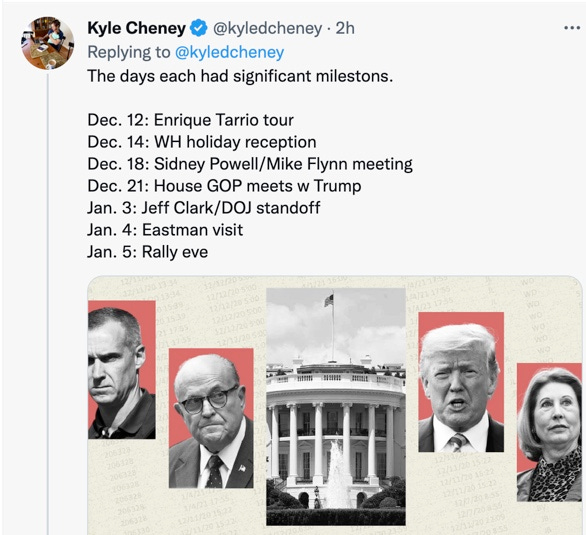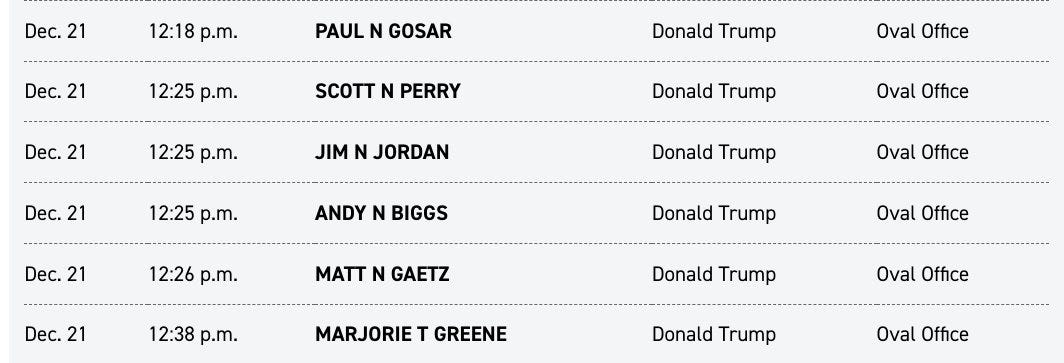Before we get to visitor logs, two things:
For those of you looking for a little distraction this week, I stumbled upon this thought-provoking but lighthearted piece from New York Times reporter Dennis Overbye, who explores the theory that our universe may be a big simulation. I couldn’t put it down. The implications are fun, if slightly scary. It was just what I needed to read this week.
On a more serious note, Republicans are saying the quiet part out loud again, lauding the success of their legislative strategy of making it impossibly difficult for people they think lean Democratic, largely Black people and other minorities, to vote.
Joan Walsh wrote in The Nation: “Just last week, we learned that a Wisconsin Republican election commissioner boasted of the party’s success in dampening Black turnout, especially in Milwaukee, last November. Thanks to the state GOP’s ‘well-thought-out, multi-faceted plan,’ commissioner Robert Spindell emailed colleagues, 37,000 fewer voters cast ballots there than in 2018, ‘with the major reduction happening in the overwhelming Black and Hispanic areas.’ It could have cost Democrat Mandela Barnes a Senate seat.”
Walsh details former Georgia Senator Kelly Loeffler’s comments touting Georgia Senate Bill 202, a February 2021 law that cut back on absentee voting and vote by mail. Walsh says Loeffler “doesn’t quite claim that the bill suppressed Black votes—though it probably did: after the bill imposed restrictions on voting by mail, mail-in ballots plunged by 81 percent from 2020, and Black voter turnout dropped from 2018 midterm levels.” Loeffler bragged that the bill helped Republican Governor Brian Kemp turn away Democrat Stacey Abrams’s challenge in his race for re-election.
Walsh’s reporting is a good reminder of something we need to keep at the forefront: the myth of rampant voter fraud, along with the insinuation that “others”—Black people, immigrants, felons—are somehow responsible for it, was circulated by Republicans long before Trump took to the political stage. It was a mainstay in the Deep South. But the allegations were always hollow, for instance in Alabama, where Republican-appointed U.S. Attorneys chased every accusation that was made for the eight years of the George W. Bush administration without finding anything of significance.
The Big Lie put the old trope on steroids, a Trump-sized version of the voter fraud complaints Republicans trotted out every election cycle. But none of it is true. Trump’s election fraud commission, appointed early in his presidency, was forced to fold in just a couple of months because they could find no evidence of voter fraud in 2016.
The real problem Americans face in elections is ongoing efforts to suppress the voting rights of people who are fully entitled and qualified to vote. That voter suppression has been abetted by our courts ever since Chief Justice Roberts wrote in Shelby County v. Holder (2013) that racial disparities in voter access had ended, gutting the protections of Section 5 of the Voting Rights Act. In successive terms, the Court has continued to erode the protection offered by the Act, making it easier for Republicans to pass laws and implement practices that have precisely the impact Loeffler applauded: making it harder for Democrats to vote.
But there’s a path forward. In the past few elections, we’ve learned that nothing outrages Americans like someone who wants to keep them from voting. We saw it in the long lines in communities whose polling place options were suddenly limited, students who stayed in incredibly long lines even when machines broke or ballots ran out, people who worked to help register voters and get them to the polls. Voter suppression is death by a thousand cuts, and it’s important to stay on top of all the ways it happens, especially when Republicans proudly proclaim their success in denying people they think won’t vote with them the right to vote. Knowing the truth is essential. Share the information with people around you so they’ll understand the importance of registering and voting. It’s going to take all of us in 2024, especially with these evolving tactics to prevent people from voting afoot.
On to visitor logs:
There’s a lot of back-and-forth about visitor logs in the news these days. Republicans want logs released for Biden’s home, in light of the whole classified-documents mess. The Secret Service says they don’t have anything to release, because materials regarding a private residence where visitors are merely screened aren’t retained permanently. Of course, that demand is purely political. The same people who are expressing outrage that there aren’t logs for Biden’s house never said a word about the Trump administration’s sudden, unexplained departure in April 2017 from the policy, now restored by the Biden administration, of making visitor logs at the White House publicly available.
Interestingly, though, there is some newly available visitor log data from the Trump White House. The January 6 committee managed to get their hands on it, and Politico issued a report this morning that puts it into a searchable format. They highlighted some of the most interesting results, interesting at least to those interested in how an attempted coup takes shape. We already know about these event from the January 6 committee report, but it’s important to see the timeline.
On December 12, 2020, the same day their leader Enrique Tarrio, currently on trial for seditious conspiracy, toured the White House, the Proud Boys’s Parler account said, “There’s been a Proud Boy at the White House for four years…” When asked about it, Trump’s spokesperson Judd Deere said, “He did not have a meeting with the president, nor did the White House invite him.” It was reported that Tarrio was on a Christmas tour. There was a report in Salon that people with felony criminal records—Tarrio had a conviction for stealing and reselling $1.2 million in diabetic test strips and had served 16 months in prison—were either denied entrance to the White House or possibly, if a high-ranking administration official intervened, permitted on a tour, though often with an assigned guide. Tarrio reportedly took the self-guided tour with a group that included a young man who had previously interned in Representative Jody Hice’s, (R-Ga), office. A White House spokesperson declined to respond when asked whether Tarrio was checked in through the visitors’ entrance or via the executive office of the president. That’s all ancient history now as Tarrio prepares for a jury to deliberate over his fate.
On December 14, the Electoral College confirmed that Joe Biden was the winner of the 2020 election.
On December 18, Trump held a now-infamous meeting with lawyer Sidney Powell, former General Mike Flynn (who pleaded guilty to criminal charges twice before Bill Barr manufactured their dismissal), and others, including members of his staff and the White House Counsel’s office, as well as former Overstock CEO Patrick Byrne. With Trump running out of options, Powell floated outrageous suggestions about overturning the election. Contemporaneous reporting suggested Trump considered appointing Powell, who promoted conspiracy theories about rigged voting machines, to investigate voter fraud, but White House Counsel Pat Cipollone and White House Chief of Staff Mark Meadows pushed back heavily. It turns out it was much worse than that.
Flynn had floated the idea on TV earlier that week that Trump could invoke martial law as part of his efforts to overturn the election. Trump reportedly questioned him about it. Another proposal involved an executive order that would permit the government to access voting machines to inspect them, and perhaps even use an executive order to seize them. Participants told the January 6 committee that the meeting devolved into a shouting match.
On December 19, Trump tweeted, “Big protest in D.C. on January 6th. Be there, will be wild!”
December 21 ushered in a busy day for Trump, full of meetings with Republican representatives. Trump met with members of what we now think of as the coup caucus. Meadows laid the topic bare in a tweet that day: “Several members of Congress”—which turned out to include GOP reps Matt Gaetz, Jim Jordan, and Mo Brooks—“just finished a meeting in the Oval Office with President @realDonaldTrump, preparing to fight back against mounting evidence of voter fraud. Stay tuned.”
As January 6 approached, Trump tried to substitute Jeff Clark for the acting Attorney General because of his professed willingness to advance the big lie and say DOJ was investigating fraud. (Barr resigned after giving an interview saying he had found none; after he left, Trump continued to press DOJ officials, telling them all they needed to do was announce an investigation and he would take it from there.) And he met with lawyer John Eastman and others who encouraged the pressure campaign to convince Mike Pence to refuse to certify the electoral college vote.
There’s been a lot of news coming at us fast these past few weeks. It’s easy to lose track of just how compelling the January 6 committee’s compilation of evidence was. Our attention span must be long, despite the distractions, even the important ones. We should be willing to explore new things as they happen in the moment but without losing focus on what we all know to be true now, after following the committee’s work and their final report. Democracy still hangs in the balance.
We’re in this together,
Joyce





You look at that group of R reps that are on the visitor log & then look at the power they still have & the committees they’ve been assigned to and it’s nauseating! When will any of them be held accountable for their actions leading up to & including J6? Will anyone politically involved in the coup ever be held to account?
Having reached cognitive saturation last week, there is no bandwidth in my mind to contain the histrionics of the GQP now they have some power. That they can not exit Santos is all that needs to be said.